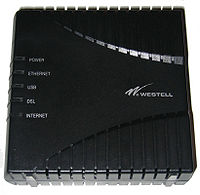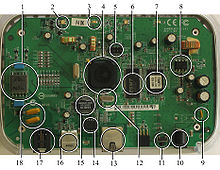- DSL modem
-
A Digital Subscriber Line (DSL) modem is a device used to connect a computer or router to a telephone circuit that has Digital Subscriber Line service configured. Like other modems, it is a type of transceiver. It is also called a DSL Transceiver or ATU-R (for ADSL Transceiver Unit-Remote). The acronym NTBBA, which stands for network termination broad band adapter, is also common in some countries.
Some DSL modems also manage the connection and sharing of the DSL service in a network, in this case, the unit is termed a DSL router or residential gateway. DSL routers have a component that performs framing, while other components perform Asynchronous Transfer Mode Segmentation and Reassembly, IEEE 802.1D bridging and/or IP routing (including network address translation). Typical user interfaces are Ethernet and Universal Serial Bus (USB). Although a DSL modem working as a bridge does not need an IP address, it may have one assigned for management purposes.
Contents
Compared to voice-band modem
A DSL modem modulates high-frequency tones for transmission to a Digital Subscriber Line Access Multiplexer (DSLAM), and receives and demodulates them from the DSLAM. It serves fundamentally the same purpose as the voice-band modem that was a mainstay in the late 20th century, but differs from it in important ways.
- DSL modems transfer data at a rate which is typically 10 to 20 times that of a voice-band modem.
- A single telephone line can be used for simultaneous voice and data with a DSL modem whereas a voice-band modem precludes simultaneous voice traffic.
- Most DSL modems are external to the computer and wired to the computer's Ethernet port, or occasionally its USB port. Internal DSL modems with PCI interface are rare but available.
- Microsoft Windows and other operating systems do not recognize external DSL modems connected by Ethernet, and hence have no Property Sheet or other internal method to configure them. This is because the transceiver and computer are considered separate nodes in the LAN, rather than the transceiver being a device controlled by the computer (such as webcams, mice, keyboards etc.). Most DSL modems and DSL modem-routers can be configured manually, using a Web page provided by the modem via the Ethernet that the router connects to. The confs generally to open a browser, type the DSL modem's LAN IP address in the browser's address bar, and then press "Enter". However, DSL modems rarely need to be configured, because they are part of the physical layer of computer networks, simply forwarding data from one medium (CAT5) to another one (telephone line).
- For external DSL modems connected by USB, Microsoft Windows and other operating systems generally recognize these as a Network interface controller.
- For internal DSL modems, Microsoft Windows and other operating systems provide interfaces similar to those provided for voice-band modems. This is based on the assumption that in the future, as CPU speeds increase, internal DSL modems may become more mainstream.
- DSL modems use frequencies from 25 kHz to above 1MHz (see Asymmetric Digital Subscriber Line), in order not to interfere with voice service which is primarily 0-4 kHz. Voice-band modems use the same frequency spectrum as ordinary telephones, and will interfere with voice service - it is usually impossible to make a telephone call on a line which is being used by a voice-band modem.
- DSL modems vary in data speed from hundreds of kilobits per second to many megabits, while voice-band modems are nominally 56K modems and actually limited to approximately 50 kbit/s.
- DSL modems exchange data with only the DSLAM to which they are wired, which in turn connects them to the Internet, while most voice-band modems can dial directly anywhere in the world.
- DSL modems are intended for particular protocols and sometimes won't work on another line even from the same company, while most voice-band modems use international standards and can "fall back" to find a standard that will work.[citation needed]
Most of these differences are of little interest to consumers, except the greater speed of DSL and the ability to use the telephone even when the computer is online.
Because a single phone line commonly carries DSL and voice, DSL filters are used to separate the two uses.
Hardware components
As technology advances, functions that are provided by multiple chips can be integrated onto one chip. Higher levels of integration have benefited DSL just as they benefited other computer hardware. A DSL modem requires the following for its operation; exactly what is on the circuit card and how it is arranged can change as technology improves:
- Power supply: Transformer and capacitor
- Data connection and power circuitry (for example, USB, Ethernet, PCI)
- DSL digital data pump
- DSL analog chip and line driver
- Micro controller
- Filter
- Transistor
Service features
Apart from connecting to a DSL service, many modems offer additional integrated features, forming a residential gateway:
- ADSL2 or ADSL2+ support
- Router functionality that includes Network Address Translation (NAT) to share a single IPv4 address.
- An 802.11b, 802.11g or 802.11n wireless access point
- A built-in switch (typically 4 ports)
- Virtual Private Network termination
- Dynamic Host Configuration Protocol (DHCP) server
- Dynamic DNS (Domain Name System) clients
- Voice over Internet Protocol functionality including Quality of Service (priority control for data flows between users)
See also
External links
- Whirlpool DSL Modem reviews
- ADSL Geek DSL Modem resource
- DSLtechTalk ADSL DSL Modem Technical resource
- Common DSL router/modem stats and errors affecting line stability and speed
Internet access Network type Wired Wireless Optical Coaxial cable Twisted pair Phone line Power line Unlicensed terrestrial bands Licensed terrestrial bands Satellite LAN Ethernet G.hn · MoCA · HomePNA Ethernet HomePNA · G.hn G.hn · HomePlug Wi-Fi · Bluetooth · DECT · Wireless USB WAN PON · Ethernet DOCSIS Ethernet Dial-up · ISDN · DSL Power line Muni Wi-Fi GPRS · iBurst · WiBro/WiMAX · UMTS-TDD, HSPA · EVDO · LTE · MMDS Satellite Categories:
Wikimedia Foundation. 2010.


